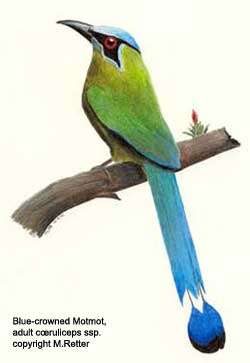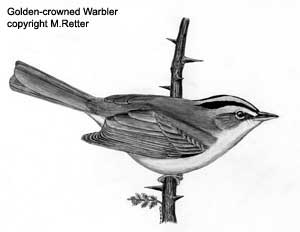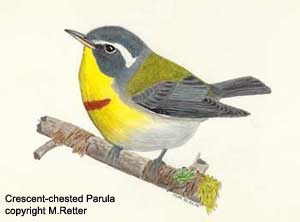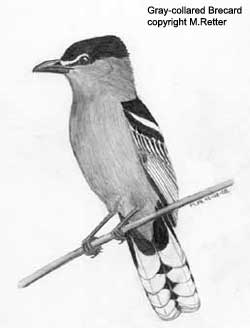
| EMAIL THIS PAGE TO PALS |
 Northeast México (Monterrey, NL; Tecolutla, Ver; Tlanchinol, Hgo; El Naranjo, SLP; and Gómez Farías, Tamps.)
Northeast México (Monterrey, NL; Tecolutla, Ver; Tlanchinol, Hgo; El Naranjo, SLP; and Gómez Farías, Tamps.)
July 28-Aug 8, 2002
Participants: Mike Freiberg: Ames, IA, Michael Retter: Bloomington-Normal, IL, Justin Rink: Bolingbrook, IL
Overview
The goal of this trip was twofold: to see as many of the NE endemics as possible, and to really get to know the birds at Tlanchinol. We missed one endemic due to time of year (Tawny-collared Nightjar) but had a very successful trip otherwise, despite to heat and the bugs. The butterflies were amazing; I highly suggest anyone into butterflies visit this area in the summer. I have mentioned the few species of butterfly I was able to identify. The only hotel we stayed at was the Hotel Victoria in Tlanchinol, which I highly recommend. Their prices had gone up (130 pesos vs. 110 for a room with two double beds, hot shower, and tv), but it's still very reasonable and very clean. Marciela, who runs the hotel restaurant is as nice as ever, and her cooking is still excellent. We ate at the hotel's 'Restaurant Mary Kay' every night with an average price of 50 pesos/person, which included 3 drinks and all the extra helpings we wanted. We camped when not staying at the Hotel Victoria.
An asterisk (*) denotes a different common name that those used in Howell & Webb. See end of report for explanations.
July 28, 2002
We crossed in the afternoon at Progresso just in time to run into rush hour traffic in Monterrey (not advised!). Not only that, but there was an hour-long detour through the heart of Monterrey because there was an accident on the main pereférico around the E side of the city. The original plan was to get to the Highrise listed in Howell (site 3.1) by sunset to see the Maroon-fronted Macawlets*, but we ended up getting there about two hours after sunset. It was really neat to drive through the huge gorge between San Isidro and La Cienaga at night.
Night: camping on the road at the Highrise.
July 29, 2002
Highrise: Howell site 3.1. An hour before sunrise, we awoke to what sounded like a group of people laughing hysterically at us. Macawlets! Although we heard dozens, we didn't see any because one of us accidentally left the scope in a car in Brownsville! DOH! Still, we pressed on. About ready to give up, we drove W to try and find some lingering Colima Warblers, but no luck there. We were entertaining ourselves watching some Lesser Goldfinches when we heard a perched group of macawlets in the pines just off the road. We climbed the hillside and couldn't find the birds. Eventually they flushed - about a dozen birds and we'd been standing directly under them. No more than naked-eye silhouette views were had, and we were pretty demoralized. Still we hung on, and hiked to the top of an open ridge towards the sound of distant macawlets. In a few minutes we were rewarded with a flock of 8 Maroon-fronted Macawlets just below eye level, no more than 15 yards away. Binoculars weren't even needed! A few minutes later we got prolonged views of a few more pairs, but they were more distant. This location was just E of San José de las Boquillas, on the S side of the road. Other birds we saw at the Highrise included Rufous-crowned Sparrow, Canyon Towhee, Couch's Mexican Jay, Blue-throated Mountain-Gem*, Bewick's Wren, Band-tailed Pigeon, Acorn Woodpecker, Hutton's Vireo, Mexican Chickadee, 'Mexican' Yellow-eyed Junco, 'Coppery-tailed' Elegant Trogon, Broad-tailed Hummingbird, 'Black-eared' Bushtit, Lesser Goldfinch, Hepatic Tanager, Greater Pewee, Brown-backed Solitaire, Canyon Wren*, White-throated Swift, Common Raven, Audubon's Oriole, Cooper's Hawk, Blue Grosbeak, and Spot-breasted Wren. The sun sat on us somewhere around Ciudad Victoria as we drove towards Tecolutla. This was a terrible drive, and the worst I've ever experienced in Mexico. Don't take the inland route from Tampico to Tuxpan! The 'highway' is terrible, with potholes bigger than my Dodge Aries.
Night: camping on the road into Tecolutla , just W of town at an abandoned installation of some kind on the N side of the road.
July 30, 2002
Tecolutla: Howell site 10.1. The bugs were terrible! And then the heat kicked in about 9 a.m., so we spent as little time here as possible. We got great looks at Altamira Yellowthroat, our main target here. We saw two males and one female, and heard many more males singing from further out in the marsh. While they do not respond to 'pishing' per se, they will respond in my experience (I've twice visited this location) quite violently to dental 'ticking' sounds. Other birds seen here included Ruddy Ground-Dove, Northern Jaçana*, Ground-Chat*, Red-billed Pigeon (common), Tamaulipas Crow, Ochre (Orchard) Oriole, Hooded Oriole (yellow males), Sulphur-bellied Flycatcher, Social Flycatcher, White-collared Seedeater, Yellow-crowned Night-Heron, Louisiana Egret*, Least Bittern, Muscovy*, Aztec [Olive-throated] Conure*, Buff-bellied Hummingbird, and Laughing Falcon. Note: Since Howell's birdfinding guide, this site has changed. You must now cross two barbed wire fenced which do over the dike as you walk north off the main road to get to the good marsh, which is a good 400 yards off the highway.

We left the Tecolutla marsh at 9 am, and proceeded to Tlanchinol, Hidalgo by way of Pachuca. Just south of Tlanchinol we stopped in what looked like good cloud forest habitat and were instantly rewarded with a very cooperative flock of Unicolored Jays feeding on red berries. Mike and Justin had never been to a cloud forest before, and after a few seconds of the jays shifted their attention to a group of Common Bush-Tanagers. I quickly pointed out that they'd see hundreds of bush-tanagers and perhaps no more jays, but I think my pleading fell on deaf ears. They would soon learn the error of their ways! We proceed through town (where we sadly heard a caged Slate-colored Solitaire) and on north to the Lontla trail (Howell site 8.11). We had a fairly productive couple hours there, finding Tawny-throated Leaftossers (heard), a Crested Guan, a displaying male Wedge-tailed Sabrewing, and a Chestnut-capped Brush-Finch being highlights. At dusk, a pair of guans started duetting, sounding like huge pygmy-owls.
Night: Hotel Victoria, Tlanchinol.
July 31, 2002
Tlanchinol: Howell site 8.11. We started at dawn along the main highway, just north of the Lontla pullout. Birds included Slate-colored Solitaire (heard), Aratinga sp., Hooded Grosbeak, White-throated Robin, Flame-colored Tanager (very common--red ssp), Wedge-tailed Sabrewing (2 lekking males), Golden-crowned Warbler, and Olivaceous and Spot-crowned Woodcreepers. Justin and Michael got excellent looks at an Eye-ringed Flatbill a short ways down the Lontla trail. This could represent a range extension, and it is very encouraging to know that part of Chris Merkord's group two weeks later also saw this species. I have heard rumors that this species has been observed in the past here. Justin and I also found a Slate-coloured Solitaire nest with one nestling, and Mike got looks at a pair of guans.
Night: Hotel Victoria, Tlanchinol.
August 1, 2002
Tlanchinol: Howell site 8.11. This was the day we figured out the Turdus songs we were hearing. Black Robin proved to be very easy to tell from White-throated. Blacks almost always double their phrases and have noticeable pauses in between, sounding very much like Brown Thrashers. White-throateds run their phrases together, more like a Bendire's. Both birds were commonly heard, and uncommonly seen. They seem to be present in equal numbers. A flock of 4-5 Azure-hooded Jays was seen on the upslope portion of the Lontla trail. 'Black-crowned' Blue-crowned Motmot was heard there, and we saw a pair of Mountain Trogons and a mixed species flock including Brown-capped Vireo, Crescent-chested Parula*, and Black-and-white Warbler.

We then moved to the other trail, which is just N of km marker 169 on the W side of the road. A male Collared Trogon, two White-bellied Emeralds, and a few Brown-capped Vireos were noted in the cloud forest. Also in this stretch we noted three interesting species of butterfly. We saw a group of Archaeoprepona spp. feeding on sap. They would often flip their wings while perched, creating a loud snapping sound. They were likely either A. amphimachus amphimacus or A. demophon centralis. Our look at the medium-brown, leaf-like underparts should eliminate A. antimache gulina if that taxon is really as white below as is depicted in De la Maza Ramírez. We saw a few males of the species Dioriste Tauropolis (range extension?). And I became well-acquainted with one of the most beautiful butterflies I have seen to this day, Eumaeus debora. We saw four of these beauties over the course of our stay at Tlanchinol, and even got to study a dead one. We heard another guan in the cloud forest and then descended into the second-growth/cattle field area. White-naped Brush-finches frequented the area off to the right, above the cattle fields. Also noted in this habitat were Yellow-throated Euphonia, Yellow-faced Grassquit, Clay-colored Robin, Blue Mockingbird, Gray Silky, Rufous-capped Warbler, Olive-sided Pewee*, Smoky-brown Woodpecker (female), and a male Hooded Yellowthroat. A massive dragonfly migration was underway here with I'd estimate close to a million passing over in a couple hours, all headed NW. It was an amazing sight. At the same time, a flock of about 45 swifts was entertaining us; it comprised about 40 Vaux's Swifts and about 5 Black Swifts. For dusk, we were on the downslope section of the Lontla trail. At 7:10 p.m., we heard a pair of Strong-billed Woodcreepers and chased them through the cloud forest. We were rewarded with excellent views. From Michael's notes: 'Explosive call: swee-CHAK! Last note very sharp but sustained somewhat, explosive and very loud. First note an upslurred whistle/whine growing in intensity and volume.'
Night: Hotel Victoria, Tlanchinol.
August 2, 2002
Tlanchinol: Howell site 8.11. We started on the km 169 trail this morning and headed down into the cattle field area. We heard Hooded Yellowthroat but were unable to get a visual. A male Blue-black Grassquit was seen, and the Olive-sided Pewee* was still there. Black-capped Siskins were abundant. We then went back to the Lontla trail. At the pullout eating berries was a very cooperative group on 4 Hooded Grosbeaks. At least 8 more were seen over the course of the day. A Sulphur-bellied Flycatcher was a surprise at this elevation. We saw a female Amethyst-throated Mountain-gem* and 2 more Wedge-tailed Sabrewings. Tawny-troated Leaftossers and Ruddy Foliage-gleaners were heard. At 7:50 p.m., just below the Lontla pullout on the trail we got looks at an immature male Gray-collared Becard.

August 3, 2002
Tlanchinol: Howell site 8.11. On the Lontla trail today. A pair of White-winged Tanagers was new. Scaled Antpitta was heard singing here, and sounded different than how Howell and Webb describes the song from south of the Isthmus of Tehuantepec. It started as a rapid trill, slowed, and sped up again, ending in a trill. Total duration was ca. 8 sec. It was only heard once. A singing Yellow-billed Cuckoo was more of a surprise to us than was the antpitta. It was becoming clear by this point that Tawny-throated Leaftossers were common. Mike briefly saw one as it flushed from underfoot. Many others sang and called from the ferns. We found a pair (ad. and imm. males) of Gray-collared Becards. A male Rose-throated Becard was associating with them, as was a Slate-colored Solitaire. This was far down the Lontla trail, just before it starts to get steep. Also rather far down the trail was what was for us, the bird of the trip. I heard a call that I recognized from a tape, and realized it was Sepia-capped Flycatcher. I then played tape of Sepia-capped Flycatcher, and two birds flew in. We were definitely out of range for Sepia-capped, so I wondered what they could be. As it turned out, the birds were a pair of Ruddy Foliage-gleaners. One bird quickly departed, but another, an immature, remained on the same perch, constantly calling. for close to a half hour as we watched it from less than five feet away. We obtained excellent video, photos, and audio tape of this bird. While running back to the car to get more film to shoot the foliage-gleaner, Mike happened across an Azure-hooded Jay feeding on the ground. It was there when he returned too, but unfortunately, the foliage-gleaner was not. At dusk Michael investigate da rusting in the leaves off the side of the trail only to be scared by a Spider Monkey. The feeling was mutual. On the mammal front, there is a black-and-chestnut-colored squirrel that is very common here.
Night: Hotel Victoria, Tlanchinol.
Aug. 4
Tlanchinol: Howell site 8.11. Our last morning in the cloud forest. Leaftossers again were common, and we heard more Ruddy Foliage-Gleaners, having learned the call. As we were preparing to leave, we hard a pair of Strong-billed Woodcreepers first singing, then calling directly across the road, upslope from the parking area. A Pale-billed Woodpecker was nice.
We then headed north to San Luís Potosí to bird around El Naranjo (Howell site 4.5). Aplomado Falcons and a Solitary Sandpiper were seen en route. We stopped at the mirador (overlook) just upstream from El Meco on the edge of town to see the falls there, and were rewarded with a flock of White-collared Swifts numbering into the triple digits.
At the 'falls proper', further upstream near the power plant, Michael got brief looks at a Green-breasted Mango.
Night: camping at the falls at El Salto, next to the power plant.
Aug. 5
El Naranjo: Howell site 4.5. Early this morning it poured, turning our campsite into a mudpit. But the rain did one nice thing: it made the falls actually flow . . . and how. A Tropical Parula was singing in the cypress trees at the campsite, and a pair of Aplomado Falcons was seen at the falls. Scrub Euphonias seemed to be common at the campsite as well.
Mid-morning we passed through El Naranjo and headed upslope towards Ciudad San Luís Potosí. On the lower stretched of the road, not far from the bridge on the western edge of town, we stopped to bird along the tributary that follows the road. We heard and saw our first Streaked Flycatchers, which reminded at least one of us of calling Hairy Woodpeckers. Yellow-green Vireos were common here, as were Black-headed Saltators. At a pulloff further up we were entertained by very tame pair of White-winged Tanagers and a Crescent-chested Parula*. Butterflies were everywhere. Of note were large numbers of White Angled-Sulphurs, crackers, and Morphos. We ended the day along the road to El Maguey del Oriente. There is a nice pulloff just about 50 yards. south of Mexico 80 on the east side of the road. Rufous-browed Peppershrikes were common and easy to see. Blue Ground-doves were very common (singing) but impossible to see. Blue-crowned Motmot and Golden-crowned Warbler were noted. After dusk, we called in a Tamaulipas Pygmy-owl by whistling and were rewarded with excellent views.
Night: Camping at the aforementioned pullout along the road to El Maguey de Oriente.
Aug. 6
El Naranjo: Howell site 4.5. We birded around the campsite at dawn. We found our first Rusty Sparrows at two locations. One pair was at the intersection of Mexico 80 and the El Maguey Rd. Another pair was down the El Maguey road a bit in a cleared area off to the right. .Just before the clearing the sparrows, in an orchard-looking area off to the right, we found a pair of Gray-collared Becards. Collared Forest-Falcon was heard here. Closer to the campsite we noted Long-billed Thrasher, Buff-bellied Hummingbird, and Dusky-capped Flycatcher. By playing tape we got looks at a family of Singing Quail mere feet away.
Higher up Mexico 80 we stopped to bird in the drier oak woodland between El Platanito and Agua Zarca. Howell mentions this area for Spotted Wren, and in three visits, I have never missed it here. Mike missed the Spotted Wrens but was more-than-compensated with fabulous looks at an Azure-crowned Hummingbird and a pair of Fan-tailed Warblers.
Night: Back at camp we were serenaded after dusk by a Tamaulipas Pygmy-owl.
Aug. 7
El Naranjo: Howell site 4.5. Near camp this morning we had Pale-billed Woodpecker, Crescent-chested Parula*, and (finally) Crimson-collared Grosbeak. By far the best way to locate the grosbeak is to listen for it shrill call. Just before El Platanito on Mexico 80 we found a pair of Blue-hooded Euphonias.
By noon we departed El Naranjo for Gómez Farías, Tamaulipas (Howell site 4.4). Arriving in late afternoon, we birded at a pulloff on the north side of the road a couple miles below Gómez Farías. Red-lored Amazons* were common, and close to hundred were using the area as a pre-dusk staging area. We heard many Thicket Tinamous. Other birds included Masked Tityra, Brown Jay, Altamira Oriole, and Barred Antshrike.
Night: Camping along the road below Gómez Farías.
Aug. 8
Gómez Farías: Howell site 4.4. We got up early to hike up to Alta Cima. Not far up the road from Gómez Farías we found a Bat Falcon. We decided to take the longer road to Alta Cima to maximize our birding time. Not too far past the fork in the road we came into an area that was home to perhaps 200 White-capped Pionus*. There were everywhere, and like any good parrot, quite loud. Other birds noted on the hike were Common Black-Hawk, Hooded Grosbeak (common), Streaked Flycatcher, Crimson-collared Grosbeak, and Squirrel Cuckoo. We saw a couple of Eighty-eights (Diaethria spp.). They were black above with bright electric blue patches. For what it's worth, I can find nothing resembling them in De la Maza Ramírez, which does not even mention this genus occurring as far north as Tamaulipas.
A large, nearly-dead tree at the information kiosk in town was heavily parasitized by some kind of vine that sported long, tubular, orange flowers. The tree was alive with dozens of hummers. Common species included Azure-crowned Hummingbird, Wedge-tailed Sabrewing, and Buff-bellied Hummingbird. One male Broad-billed Hummingbird was observed.
In Alta Cima we ate at the restaurant attached to the "zoo", and ate very well. While dining a female Archilochus flew into the restaurant and sent our heads spinning, both figuratively and literally. Try as we might, we could make it into neither a Black-chinned nor a Costa's (our other guess). It ended up being a Ruby-throated Hummingbird, coming to that realization only after seeing a male Ruby-throat outside the restaurant a few minutes later.
A Bronze-winged Woodpecker was noteworthy on the hike back down to Gómez Farías (via the shorter road).
In Gómez Farías itself we noted a Short-tailed Hawk, a Masked Tityra, and a group of Yellow-winged Tanagers.
We ran into Chris Merkord in town, in the early afternoon, and then started the drive home. We stopped briefly at the river cross on Mexico 85, just north of the Gómez Farías road. The only bird of note was a Louisiana Waterthrush. We then drove north through Cd. Victoria and crossed the border at the new bridge in Brownsville.
* Common names differing from those used in Howell and Webb. The name used in this report comes first.
Louisiana Egret = Tricolored (Louisiana) Heron
Muscovy = Muscovy Duck
Northern Jacana = Northern Jacana
Maroon-fronted Macawlet = Maroon-fronted Parrot
Aztec Conure = (Aztec) Olive-throated Parakeet
White-crowned Pionus = White-crowned Parrot
Red-lored Amazon = Red-lored Parrot
Blue-throated Mountain-Gem = Blue-throated Hummingbird
Amethyst-throated Mountain-Gem = Amethyst-throated Hummingbird
Olive-sided Pewee = Olive-sided Flycatcher
Crescent-chested Parula = Crescent-chested Warbler
Ground-Chat = Gray-crowned Yellowthroat